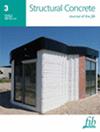Accelerated external sulfate attack: Improved laboratory methods, considering physical and chemical processes
IF 3.3
3区 工程技术
Q2 CONSTRUCTION & BUILDING TECHNOLOGY
引用次数: 0
Abstract
The most common and well‐known method for evaluating the sulfate resistance of cement blends is ASTM C1012 procedure. It takes at least 12–18 months to evaluate the results, considering this standard. The present research proposes two supplementary methods to accelerate the sulfate ions penetration into the mortar bars used in ASTM C1012. Both of these two supplementary methods were evaluated by studying mortar samples' expansion, mass change, visual condition, compressive strength, ultrasonic pulse velocity, and XRD. In the first method, a developed device provided an electrical conduction environment for mortar bars made of three cement blends. The results showed that this method produced between 8 and 16 times more expansion considering different studied cement blends. In the second method, mortar bars of seven cement blends were exposed to a devised prior condition under vacuum. Considering the results, this method produced between 2.5 and 9 times more expansion in relation to each cement blend and approach. Additionally, an excellent polynomial correlation was observed between the expansion of new accelerated methods and ASTM C1012 results. It can be concluded that using these accelerated methods as complementary to ASTM C1012 can help to evaluate the sulfate resistance of cement blends in a shorter time period.加速外部硫酸盐侵蚀:改进实验室方法,考虑物理和化学过程
ASTM C1012 程序是评估水泥混合材抗硫酸盐性能的最常用、最著名的方法。考虑到这一标准,评估结果至少需要 12-18 个月的时间。本研究提出了两种补充方法,以加速硫酸根离子渗透到 ASTM C1012 所用的砂浆棒中。通过研究砂浆样品的膨胀、质量变化、视觉状况、抗压强度、超声波脉冲速度和 XRD,对这两种辅助方法进行了评估。在第一种方法中,开发的装置为三种水泥混合物制成的砂浆棒提供了电导环境。结果表明,考虑到所研究的不同水泥混合物,这种方法产生的膨胀率提高了 8 到 16 倍。在第二种方法中,七种水泥混合物制成的砂浆棒在真空条件下暴露于设计的先期条件下。结果表明,这种方法产生的膨胀率是每种水泥混合料和方法的 2.5 到 9 倍。此外,在新加速方法的膨胀率与 ASTM C1012 结果之间还发现了极好的多项式相关性。可以得出结论,使用这些加速方法作为 ASTM C1012 的补充,有助于在更短的时间内评估水泥混合材的抗硫酸盐性能。
本文章由计算机程序翻译,如有差异,请以英文原文为准。
求助全文
约1分钟内获得全文
求助全文
来源期刊

Structural Concrete
CONSTRUCTION & BUILDING TECHNOLOGY-ENGINEERING, CIVIL
CiteScore
5.60
自引率
15.60%
发文量
284
审稿时长
3 months
期刊介绍:
Structural Concrete, the official journal of the fib, provides conceptual and procedural guidance in the field of concrete construction, and features peer-reviewed papers, keynote research and industry news covering all aspects of the design, construction, performance in service and demolition of concrete structures.
Main topics:
design, construction, performance in service, conservation (assessment, maintenance, strengthening) and demolition of concrete structures
research about the behaviour of concrete structures
development of design methods
fib Model Code
sustainability of concrete structures.
 求助内容:
求助内容: 应助结果提醒方式:
应助结果提醒方式:


